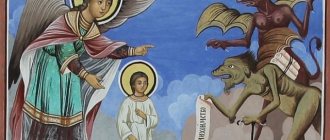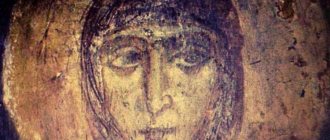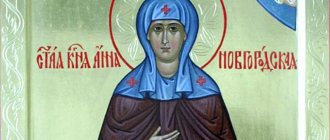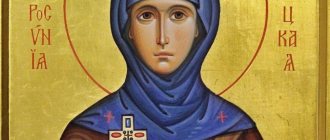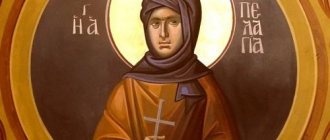Holy Martyr Svetlana (or Photinia)
- a Palestinian hermit who lived in the 5th century in Israel and is revered in the Orthodox Church.
Life
At sea during a storm, the ship was driven onto rocks and smashed into pieces. None of the passengers escaped, except for one girl, who managed to grab a board and swam to the rock where blessed Martinian labored. He helped Svetlana (that was the girl’s name) climb the rock. He told her about his life on the rock, about the shipman’s visits to it three times a year, blessed the maiden, left her bread and water and threw himself into the sea. Dolphins helped him reach land.
Svetlana was left alone to perform her feat in the name of the Lord. After some time, the shipman arrived, brought bread and water to Martinian, and found a woman on the rock. Svetlana told everything to the shipbuilder; she refused the shipbuilder’s offer to transport her to the city, but asked him to arrive with his wife and bring her men’s clothing and wool for needlework.
The shipbuilder fulfilled her request, and Svetlana continued her ascetic life. She lived in the open air both day and night, in heat and cold, and praised the Lord for her life.
Every day she offered twelve prayers to God, and every night she stood in prayer twenty-four times. A pound of bread provided her with food for two days.
After six years of ascetic life on the island, Svetlana died. Already two months after her death, when the shipman and his wife arrived in due time, they found blessed Svetlana dead forever. Saint Svetlana was buried in the city of Caesarea in Palestine.
Photinia translated from Palestinian means “bright”, which is why at baptism girls with the name Svetlana receive the church name Photinia.
The image of Saint Svetlana (Photina, Fotinia) of Palestine teaches us love for the Lord and love for life. How often we get upset, blame fate, are dissatisfied, we always lack money, food, entertainment. And then we are ready to hate our life, blaming providence for injustice. Saint Svetlana (Photina) miraculously escaped death; she accepted what happened as a gift from the Lord and did not want to waste the years allotted to her. Her feat makes a person look at life differently. In any circumstance, no matter what happens, we should be grateful for her.
Troparion
In you, mother, it is known that you were saved in the image: having accepted the cross, you followed Christ, and in action you taught to despise the flesh: for it passes away, but be careful about the souls, things that are immortal. In the same way, the venerable mother Svetlana, your spirit will rejoice with Angela.
Greatness
We bless you, reverend mother Svetlana, and honor your holy memory: you pray for us to Christ our God.
Prayer
Pray to God for me, holy servant of God Fotino, as I diligently resort to you, an ambulance and prayer book for my soul.
Lives of Saints Martinian, Zoe and Photinia (Svetlana)
From the age of 18, the venerable Mar-ti-ni-an lived in the desert, near the city of Ke-sa-ria Pa-le-stin-skaya, where about -was in motion and silently for 25 years, having been blessed with the blessing of curing the disease. However, the enemy did not leave the enemy, launching various personal attacks on him. Once upon a time, a woman had an argument with depraved people who were seducing the holy Marty. no, the fame of a good life has spread throughout the city. She came to him at night under the guise of a stranger, asking for the night. The saint let her in because the year was stormy. But then the sweet guest changed into nice clothes and began to seduce the movement. Then the saint came out of the cell, lit a fire and stood barefoot on the flaming coals. At the same time, he said to himself: “It’s hard for you, Mar-ti-ni-an, to endure this temporary fire, how will you endure it forever?” what kind of fire did you prepare for the dia-vol-lom?” The woman, captivated by this sight, became excited and asked the saint to put her on the path to salvation. nia. At his direction, she went to Beth-le-em, to the monastery of St. Paul, where she lived in strict 12 years until his blessed death. The woman's name was Zoya.
Having suffered from burns, Saint Mar-ti-ni-an fled to an uninhabited rocky island and lived under the covered by the sky for several years, eating food that a ship's worker brought him from time to time, and he wove baskets for him in a special way.
Once upon a time, during a strong storm, a ship crashed, and to the island where Saint Mar-ti-ni-an was sleeping, -we brought a de-vi-tsu named Fo-ti-niya to the scrapyard. Saint Mar-ti-ni-an helped her get to the island. “Stay here,” he told her, “here’s bread and water, and in two months the ship-builder will come,” and he himself I pushed myself into the sea and swam. Two del-fi-na you carried him to land. Since then, the blessed Mar-ti-ni-an began to lead the life of the countries. This continued for two years. One day, having arrived in Athens, the saint fell ill and, sensing the approach of his death, entered the temple, lay down on the floor, he called the bishop and asked him to offer his body for burial. This happened around 422.
The blessed girl Fo-ti-niya stayed to live on the island, where she spent 6 years in solitude, and then from la God-gu do-shu. Con-chi-well, it was opened by the same ship-builder, who greeted her, just like the most kindly Mar-ti-ni-a-nu, pi-shu. He transported the body of the blessed Fo-ti-nii to Ke-sa-ria Pa-le-stin-skaya, where it was honorably well-needed but episcopal and clergy. The memory of the dear Zoya and Fo-ti-nii is celebrated on the same day.
See also: "" in the book of St. Di-mit-ria of Ro-stov.
Brief lives of the martyr Photina (Svetlana) Samaritan and others
This is that same-na-sa-ma-ryan-ka, with which the Lord came at the well of Eeyore (). Passion-da-la for Christ under the name of Nero in Rome, in 66. St. Fo-ti-na lived at that time in Carfa -gene. Having received information from the Lord about the suffering ahead of her, she went to Rome and, together with sons-no-vya-mi Yosi-ey and Fo-ti-nom (Vik-to-rom) and sisters-ra-mi Ana-to-li-ey, Pa-ras-ke-voy, Ki-ri-a -ki-ey, Fo-to and Fo-ti-doy freely came to Nero. After many torments, which did not harm her, the saint was from-ve-de-na in “Zolo-toi” Nero's house, where his daughter Dom-ni-nu and 100 of her slaves were converted to Christ.
Three years later, having again endured much torment and skin scraping, St. Mu-che-ni-tsa Fo-ti-na was thrown into the well, where she died. Together with her, both of her sons, sisters, mu-che-ni-tsa Dom-ni-na and mu-che-nick Se-va-sti- suffered for Christ. an.
Complete lives of the martyr Photina (Svetlana) Samaritan and others
The holy mu-che-ni-tsa Fo-ti-na was the same-my-sa-ma-ryan-coy, with whom the Spa-si-tel was -boat Ia-to-left-va (). During the time of Nero (54-68), he showed extreme toughness in the fight against cancer. sti-an-stvo, the holy Fo-ti-na lived in Car-fa-gen with her youngest son Josiah and there without-bo-language-but-about -ve-do-va-la Evan-ge-lie. Her eldest son Viktor bravely fought in the Roman armies against the barbarians and was appointed to the military for his services -chal-ni-kom to the city of At-ta-liyu (Asia Minor).
Grad-do-chal-nik At-ta-lii Se-va-sti-an, when meeting with Saint Victor, told him: “I know very well, that you, your mother and your brother are followers of the teachings of Christ. But I, in a friendly way, co-vet you - comply with them, for this you will receive money. the quality of Christianity that you provide to us. I tell them your ma-te-ri and brother, so that they don’t pro-ve-do-wa-Christ from the open. Let them secretly practice their faith.” Saint Victor answered: “I myself want to be a pro-Christianity, like my mother and brother.” To this Se-va-sti-an responded: “Oh Viktor, we all know very well what kind of disasters await you for this, mother and your brother.” After these words, Se-va-sti-an suddenly felt a sharp pain in his eyes, his face changed and he became numb.
For three days he lay there blind, without saying a word. On the fourth day, unexpectedly, he said loudly: “Only the faith of Christ is true, there is no other true faith.” -ry!” On-ho-div-she-mu-sya near the house of St. Vic-to-ru Se-va-sti-an said: “Christ calls me.” . Soon he was baptized and immediately became mature. The servants of the holy Se-va-sti-a-na, sv-de-te-li-chu-yes, were baptized according to the example of their lord -on the.
Rumors about what had happened reached Nero, and he ordered to bring Christians to him for trial at the time when the Lord Himself revealed He told the people and said: “I will be with you, and Nero will be defeated, and everyone who serves him.” The Lord spoke to Saint Viktor: “From this day on, your name will be Fo-tin - “Light-of-the-earth”, for many , those who are enlightened, turn to Me.” The Lord encouraged the Holy Se-va-sti-a-na: “Blessed is the woman who completes his feat to the end.” Holy Fo-ti-na, from the Spa-si-te-lem about the upcoming sufferings, in co-pro-gov-de-nii several -Khi-khri-sti-an came from Car-fa-ge-na to Rome and joined the s-scientists.
In Rome, the im-per-ra-tor invited the saints to his place and asked them whether they really believed in Christ - hundred. Everyone decided to renounce the Savior. That's when they-per-ra-tor, at the-ka-hall, beat-drop-the-hands of the holy mar-ties on the ko-valley. But during the test, it is not the feeling of pain, but the hands of the mu-che-ni-tsy Fo-ti-ny remain -we were unharmed. Nero ordered Saints Se-va-sti-a-na, Fo-ti-na and Josiah to be blinded and imprisoned, and Saint Fo-ti- well, with her five sisters - Ana-to-li-ey, Fo-to, Fo-ti-doy, Pa-ras-ke-voy and Ki-ri-a-ki-ey - from- go to the im-per-tor-palace under the supervision of do-che-ri Nero-on the House-ni-ny. But Saint Fo-ti-na converted to Christ the House-ni-nu and all her slaves who received Holy Baptism . She turned to Christ and the sorcerer, who brought poisoned drink to kill the priest.
Three years passed, and Nero sent for one of his servants who was in prison. The messages sent to him were that the saints Se-va-sti-an, Fo-tin and Josiah, who were blind, became co- you are absolutely healthy, and they are constantly visited by people who listen to them; she herself, however, turned into a bright and blissful place, where God is glorified. Then Nero ordered the five saints to hang their heads down and beat them on their bodies with belts for three days . On the fourth day, im-per-ra-tor sent servants to see if you were alive. But, having arrived at the place of torture, the sent ones immediately became blind. At this time, the Angel of the Gos-daily liberated the mu-che-niks and healed them. The saints took pity on the blind servants and their prayers to the Lord to restore their sight. They matured to believe in Christ and were soon baptized.
In a powerless rage, Nero ordered to tear off the skin from Saint Fo-ti-na and throw the mu-che-ni-tsu into the well. Mu-che-ni-kam Se-va-sti-a-nu, Fo-ti-nu and Josiah from-sek-li go-le-ni, bro-si-li so-ba-kam, then with They skinned them. The sisters of Saint Fo-ti-na endured terrible torment. Nero ordered to cut off their nipples and then rip off the skin. Sophisticated in his cruelty, he-per-ra-tor arranged the same execution of Saint Fo-ti-de: she was blamed by the legs to the top of two inclined trees, which, straightening out, tore apart the mu-che-ni-tsu. The rest of the im-per-ra-tor will be de-headed. Holy Fo-ti-well, you came out of the well and locked it in that place for 20 days.
After this, Nero called her to him and asked if she was still alive and would not sacrifice to idols. Saint Fo-ti-na sp-nu-la him-pe-ra-to-ru in the face and, laughing at him, said: “It’s ungodly.” A blind, lost and mad man! Do you really consider me so unreasonable that I would agree to renounce my Lord Christ and sacrificed to blind idols like you?!”
Having heard such words, Nero again ordered to throw the mu-che-ni-tsu into the well, where she gave up her spirit to the Lord († approx. 66).
See also: "" in the book of St. Di-mit-ria of Ro-stov.
Prayer of Venerable Photinia of Palestine
Saint Photinia of Palestine patronizes women named Svetlana. People turn to her in all sorts of everyday needs: illnesses, family troubles, unfavorable material circumstances, when there is absolutely no means of subsistence; before a trip, the saint helps to avoid problems along the way. Travelers who go on vacation at sea order a prayer service to Photinia so that trouble does not happen on the water.
A personal icon of Saint Svetlana is always an appropriate gift for women who bear this airy name. Especially the image made of beads. In the fire of a candle or in the shimmer of sunlight, the image on the icon becomes especially enchanting.
Prayer to Saint Photinia
Oh, Holy Martyr Photino. Immensely inspired by love for Christ, you have shown courage, patience and great strength with your sisters, sons and those enlightened by you.
She preached the Gospel of Christ with boldness, and by appearing to you and everyone who was with you, Christ strengthened and comforted everyone for the coming torment.
Having come to Rome and fearlessly confessing Christ, you were imprisoned and endured much torment, thrown into a well, and betrayed your soul to the Lord.
Hear us, Saint Photino, who shone with spiritual beauty and constantly and incessantly taught people faith in Christ, in prison and in cities.
Hear us, looking at us sinners and with the grace of Christ heal those who are sick with fever, so that the rain of sin will not sprinkle them, but in mental and physical health they will spend their lives without weakening in good deeds and glorify the Lord of all, the Father of bounties, the Merciful God, in all ages. Amen.
Venerable Photinia of Palestine
Subscribe to the YouTube channel - “Embroidery of icons with beads and stones”. There will be a lot of interesting things.
We are VKontakte – “Embroidery of icons”
Prayer to the icon Recovering the dead
Tips and tricks
They voice their requests, fears and hopes by turning to the archangels. They are the leaders of the heavenly army, consisting of angels, and are called upon to monitor heavenly and earthly order.
After requests made on the eve of upcoming events or after the event, confessors advise following some important rules:
appeals to heavenly powers should be accompanied by periods of complete concentration, loneliness, immersion in one’s own inner world; at this stage it is advised to refrain from excessive consumption of food and not to think about material values; An important rule of emotional outpouring is honesty before the face of a saint, admitting one’s own mistakes.
At the end of the conversation with their patron-intercessor, they always say: “Amen” and make the sign of the cross. The best option is to have a secluded place in the house where you can install icons, place lamps or church candles.
We advise you to study the Icon of the Mother of God “Mammal”
Holy Martyr Photinia
The holy martyr Photinia (Svetlana) was the same Samaritan woman with whom the Savior talked at Jacob’s well. During the time of Emperor Nero in Rome, in 65, who showed extreme cruelty in the fight against Christianity, Saint Photinia lived with her children in Carthage and fearlessly preached the Gospel there. In 2004, with the blessing of Bishop Philip of Poltava, a particle of the relics of this holy martyr was transferred to our church.
Prayer to the Holy Martyr Photinia
Oh, Holy Martyr Photino. Immensely inspired by love for Christ, you have shown courage, patience and great strength with your sisters, sons and those enlightened by you. She preached the Gospel of Christ with boldness, and by appearing to you and everyone who was with you, Christ strengthened and comforted everyone for the coming torment. Having come to Rome and fearlessly confessing Christ, you were imprisoned and endured much torment, thrown into a well, and betrayed your soul to the Lord. Hear us, Saint Photino, who shone with spiritual beauty and constantly and incessantly taught people faith in Christ, in prison and in cities. Hear us, looking at us sinners and with the grace of Christ heal those who are sick with fever, so that the rain of sin will not sprinkle them, but in mental and physical health they will spend their lives without weakening in good deeds and glorify the Lord of all, the Father of bounties, the Merciful God, in all ages. Amen.
Troparion to the Martyr, tone 4
Your Lamb, Jesus, Photinia, calls with a great voice: I love You, my Bridegroom, and, seeking You, I suffer, and I am crucified, and I am buried in Your baptism, and I suffer for Your sake, for I reign in You, and I die for You, yes and I live with You: but, as an immaculate sacrifice, accept me, sacrificed to You with love. With your prayers, as if you are merciful, save our souls.
Kontakion to the Martyr, tone 2
Your all-honorable temple, as if you have found spiritual healing, all the faithful cry out loudly to you: virgin martyr Photinia, most famous, pray to Christ God unceasingly for all of us.
Glorification of the martyr
We magnify you, passion-bearer of Christ Photinia, and honor your honest suffering, which you endured for Christ.
How to find out which St. Svetlana is your heavenly patroness
The Greek name Photinia in Russian sounds like Svetlana. And in the church calendar there is an indication that this is the same name.
At baptism, a person is given a name in honor of the saint, who becomes his heavenly patron. As a rule, the saint whose day of veneration is closest to the Christian’s birthday is chosen. That is, if the birthday is July 29, then Photinia of Cyprus will be considered the patron saint, and if May 1, then Photinia of Samaritan will be considered the patron saint.
Why do you even need to pray to the heavenly patron if each Christian, upon receiving the Sacrament of Baptism, receives a guardian angel as protectors? Saint Theodore of Edessa says that the disembodied spirit - an angel - protects us from all evil and helps us do good, and the saint of God, whose name we bear, is the first intercessor for us before God. The prayers of the saint are more pleasing to God than our sinners, and therefore are more likely to be accepted.
We pray to the heavenly patron in every need - he, as our closest comrade-in-arms in the matter of saving our souls, cares and takes care of us in all sorrows and adversities.
The example of Photinia the Samaritan woman is an example of selfless service to the Lord. The life of this woman before meeting the Savior was not a model of morality and piety, but faith changed her. Having embarked on the path of apostolic service, Photinia showed an invincible spirit and incredible fortitude in the face of her tormentors. For the terrible suffering she suffered for Christ, she was canonized as a martyr.
This is interesting: Icon of the Holy Martyr Galina: a detailed look at the question
Saint Photinia: icon, prayer, angel day
The history of the Orthodox religion knows many examples of people who suffered severe hardships and torment for the sake of spirituality and affirmation of faith. One of these is Photinia, a saint who preached Christianity at the dawn of its path, during times of severe persecution. The famous ascetic has repeatedly demonstrated the miracles of prayer and converted thousands of people to faith. Believers still turn to her image with requests for help and healing from serious illnesses.
Parable of Living Water
There is a chapter in the Gospel of John that tells about Christ’s meeting with the Samaritan woman. In those distant times, Jews and Samaritans (settlers from Mesopotamia) lived in cold hostility. Preaching the Gospel, Jesus traveled through the Samaritan lands. Stopping near the city of Sychar, he wanted to drink water from Jacob's well. Just at that moment a young woman approached. It was Photinia (angel day - April 2, new style). Christ asked her for help, which greatly surprised the woman, because he was a Jew. Jesus answered her that if she knew who she was talking to, she would have asked Him for living water, which would become the source of eternal life. Christ spoke about the Christian faith. He also told the details of her life, pointed out her sins, and Photinia immediately recognized Him as a prophet. She returned to the city of Samaria and told everyone about the coming of the Savior, after which many Samaritans believed in the Messiah and turned to the Christian faith.
Emperor Nero
After this significant meeting, Photinia (Svetlana) went to Carthage (North Africa) to preach Christianity there. Despite the persecution of the pagans, she did this openly, fearlessly and selflessly. When the apostles Paul and Peter were killed, Jesus appeared to her in a dream and ordered her to go to Rome, to Emperor Nero, to continue the spiritual path of her predecessors. Together with five sisters, the ascetic set about fulfilling the mission. At that time there was severe persecution of Christians in Rome. Arriving at the palace, Photinia and her sisters were captured by the pagans. Nero ordered the women's hands to be cut off. But no matter how hard the guards tried, they could not do this; they themselves fell to the ground, writhing in pain. And the wounds that they managed to inflict on them immediately disappeared.
Temptation of Photinia
Then the cunning and arrogant Nero, not wanting to believe in Christ, decided to tempt Photinia and her companions. He settled her in the palace, treated her to delicious, exquisite dishes, and surrounded her with a hundred slaves to serve her. The emperor’s daughter, Domina, was also there. Forty days later, he visited Photinia and was very surprised when he learned that all the slaves around her, including his daughter, had converted to Christianity.
The enraged Nero ordered Photinia to be flayed and then thrown into a dry well. The same fate befell the sisters of the martyr. A few days later, Photinia was taken out of the well; she was still alive and did not renounce her faith. Then she was locked in prison for another 20 days. And again Nero summoned her to his palace, but even then he did not get her to bow down and accept paganism. Photinia just laughed and spat in his face. After which she was thrown into the well again.
This is how the martyr Photinia ended her earthly life. Before her death, the saint did not renounce Christ, amazing the pagans with miracles of prayer. She was numbered among the holy great martyrs, who still patronize those in need and those who doubt their faith.
The Gospel story about the meeting of the Savior and Photinia has been reflected more than once in fine art. Examples are the fresco in the church house of Dura Europos, made around the 3rd century (only the figure of the Samaritan woman has survived to this day), and the mosaic in the Ravenna church of Sant'Apollinare Nuovo (around the 6th century).
The memory of Saint Svetlana lives on in icon painting. The most ancient icons depicting the martyr date back to the 19th century. It is believed that her images help people strengthen their spirit, overcome the temptations of sin, and gain the firmness of faith that Photinia once brought to the Samaritans. Her icon patronizes not only women named Svetlana, but also all those who suffer.
Saint Svetlana protects mental and physical health. Her image in the house is the key to a strong family, prosperity and understanding between generations, protection from evil intentions and deeds.
Christian legends claim that upon meeting the Savior, Saint Photinia received power over the water element. Therefore, she managed to survive when she was thrown into a well by the Roman pagans, and heal people with fever. Saint Svetlana helps people with a similar illness.
Photinia had two sons - Josius (Joseph) and Victor. The first helped his mother in preaching the Gospel, the second was a Roman military commander. They also had hardships and temptations of faith in their lives. However, their mother’s wise guidance and prayer helped them overcome all this. Today, turning with sincere faith to the image of the great martyr, many mothers find consolation and resolution of problems with their children. Saint Photinia (prayer to her inspires believers and gives them confidence in their own abilities) teaches not to be afraid of difficulties. Therefore, you can turn to her with prayer not only on the days of remembrance, but every day:
“Pray to God for me, holy saint of God, great martyr Photinia, as I diligently resort to you, an ambulance and prayer book for my soul.”
Miracles of Healing
There are cases when appeals to the image of Photinia helped to recover from serious diseases of the skin, musculoskeletal system, and to overcome fever. Today, her image reminds believers that they need to do good and believe with all their souls, despite all trials.
When the Roman executioners tortured the martyr, thanks to the power of prayer she remained unharmed, her wounds healed quickly and without a trace. With her life, Saint Photinia proved that miracles are possible when you believe in them and, with the power of faith, you create them yourself.
Holy places
The biblical story of the meeting of Christ and the Samaritan woman Photinia has real geographical confirmation. In Israel, one of the most beautiful and picturesque places that attracts thousands of pilgrims is Jacob's Well (Jacob). Next to it is an ancient temple, which was destroyed three times and rebuilt again. The well itself reaches 40 meters in depth. The water from it is considered healing.
The relics of Photinia the Samaritan are kept on the island of Crete, in the village of Fodele, in the convent named after the Great Martyr. Streams of pilgrims flock here every year to strengthen their faith and ask for help in resolving spiritual problems.
On the territory of the CIS there are many churches of St. Photinia, where her Christian feat is revered and miraculous images are located. One of these is the Church of the Great Martyr in Dnepropetrovsk.
Photinia Palestine
In Christian sources there is a story about another ascetic of the faith with the name Photinia (angel day - February 26, new style). She was from Caesarea, so she received the prefix Palestine. During a storm, the ship on which she was sailing with other passengers was wrecked. Clinging to the board, Photinia was the only one who escaped and swam to the island where Blessed Martinian was in prayer and fasting. He converted the woman to the Christian faith and left the island. Three times a year a ship visited the island and brought food. Photinia of Palestine remained to live on the rock and continued Martinian’s asceticism. She spent six years in fasting and prayer, and then she died and was buried in her native Caesarea.
Saint Photinia (her life dates back to the 5th century) helps people find faith, improve mental and physical health, and also patronizes sailors.
Photinia Cyprus
There is another legend about Photinia of Cyprus. Her life dates back to approximately the 15th century. She was born in Karpasia (eastern Cyprus) into a pious family. In her youth, she decided to become the bride of Christ and left her father's house. Photinia settled in a cave, devoting herself to fasting and prayers. Soon the virgin was filled with the grace of God and began to perform miracles of healing. The news of this spread throughout the island and beyond. Many Christians turned to her for advice and to maintain spiritual strength.
Today, the cave in which Saint Photinia once labored is a place of pilgrimage. There is a throne and a deep spring in it, and the liturgy is read. Every new moon, water with a thin film of sand rises in the source. It is believed that water provides healing from many diseases, and sand is smeared on the eyes of the blind to gain insight. The cave is located near the Cypriot village of Agios Andronikos. And the relics of the ascetic herself are placed in the Church of the Apostle Andrew. The saint's memorial day falls on August 2 (new style).
Thus, there are three days a year when all Svetlanas celebrate their name day. But this is not an ordinary holiday, but a day of remembrance of the patron saint, deep in a spiritual sense. Here the matter is not limited to feasts and gifts. According to Christian tradition, on the day of St. Photinia-Svetlana, they go to church, confess, and partake of the Holy Mysteries. They also turn with a grateful prayer to the Lord and patroness.
Saint Photinia (Samaritan) is also remembered in the fifth week of Easter. At this time, the liturgy is read, prayers of thanks and praise are offered for the martyrdom in the name of the Christian faith.
Orthodox Life
The Temple of St. Photinia the Samaritan is an Orthodox church of the monastery of St. Photinia the Samaritan of the Jerusalem Orthodox Church. Located on the site of the Gospel conversation of the Savior with the Samaritan woman at the ancient well of Jacob.
Nowadays the city is called Nablus (the Arabic version of the Greek name Neapolis) in Samaria. The biblical name of the city is Shechem. Here the forefather Abram spoke with God (Genesis 12:6-7). Subsequently, the forefather Jacob lived here and dug a well (Gen. 33:18-20; John 4:12). Centuries later, at the well, the Lord Jesus Christ talked with the Samaritan woman about living water and revealed to her that He was the Messiah (John 4: 1-44). In the Roman era, near the disappeared Shechem, the Roman colony of Flavia Neapolis arose, where around 100 AD. born Christian apologist St. Justin Philosopher.
On the site of the Gospel conversation of the Savior with the Samaritan woman at the ancient well of Jacob there is a Greek monastery built on the territory of a Byzantine temple of the 4th century, destroyed in the 6th century.
In 1914, the Jerusalem Patriarchate began the restoration of the temple with the financial support of Russia, interrupted by the First World War. Completion and consecration took place only in 2008.
Here in 1979, Archimandrite Philumen, who served in this temple and was known as a man of high spiritual life, was killed by religious Jewish fanatics.
Shortly before the murder, a group of people came to the monastery and demanded that the crosses and icons be removed from Jacob's Well under the pretext that the symbols of Christianity prevented them from praying in this sacred place for them. The abbot of the monastery refused to do this, recalling that Jacob’s Well was and remains an Orthodox shrine for many hundreds of years. In response, a threat was made that if he did not leave there, he should prepare for the worst. Shouting blasphemies, obscenities, and threats against Christians, the Jews left. On the day of remembrance of St. Apostle Matthew, the murderers broke into the monastery. They inflicted two cross-shaped wounds on Father Philumen's face with an ax, gouged out his eyes and cut off the fingers of his right hand piece by piece. They also desecrated the church itself: they cut the crucifix, desecrated sacred vessels and committed other blasphemous acts. Israeli civilian authorities announced that an investigation was underway, but no results were forthcoming.
The archimandrite was buried in Jerusalem, at the residence of the Jerusalem Patriarchate in Zion. A few years later, his tomb was opened, and the relics were found almost completely incorrupt. On August 29, 2008, before the consecration of the Temple of Photini the Samaritan Monastery over Jacob's Well, the relics from Jerusalem were transferred here to ancient Shechem (Nablus).
On September 11, 2009, Philumen the Holy Sepulcher was canonized as a martyr by the Patriarch of Jerusalem Theophilus III. On March 5, 2010, the Holy Synod of the Russian Orthodox Church decided: “to include the name of the Hieromartyr Philumenes (Hasapis) in the calendar of the Russian Orthodox Church with the establishment of the celebration of his memory on November 16/29, as established in the Jerusalem Church.”
Shrines:
- Jacob's Well. Currently, Jacob's well is located in a crypt located under the altar of a large monastery church dedicated to Photinia the Samaritan.
- The jug into which the Samaritan woman collected water. It stands honorably on the inner column on the left side of the temple, at a height of several meters, behind dense cut glass.
- Piece of the relics of John the Baptist
- Shoe of St. Spyridon of Trimifuntsky (from the vestments that are periodically changed for him)
- Relics of the Hieromartyr Philumen the Holy Sepulchre
Based on materials from azbyka.ru
Martyr Photina (Svetlana)
Samaritan Woman (Samaritan, Roman)
The holy martyr Photina was the same Samaritan woman with whom the Savior talked at Jacob’s well (John 4:5 – 42).
During the time of Emperor Nero (54 - 68), who showed extreme cruelty in the fight against Christianity, Saint Photina lived in Carthage with her youngest son Josiah and fearlessly preached the Gospel there. Her eldest son Victor bravely fought in the Roman troops against the barbarians and for his services was appointed military commander in the city of Attalia (Asia Minor).
The mayor of Attalia, Sebastian, when meeting with Saint Victor, told him: “I know for certain that you, your mother and your brother are followers of the teachings of Christ. But I advise you in a friendly way - submit to the will of the emperor, for this you will receive the property of the Christians whom you deliver to us. I will write to your mother and brother so that they do not preach Christ openly. Let them confess their faith in secret.” Saint Victor replied: “I myself want to be a preacher of Christianity, like my mother and brother.” To this Sebastian replied: “O Victor, we all know well what disasters await you, your mother and brother for this.” After these words, Sebastian suddenly felt a sharp pain in his eyes, his face changed and he became numb.
For three days he lay blind, without uttering a word. On the fourth day, he suddenly said loudly: “Only the faith of Christians is true, there is no other true faith!” Sebastian said to Saint Victor, who was nearby: “Christ is calling me.” Soon he was baptized and immediately received his sight. The servants of Saint Sebastian, witnesses of the miracle, were baptized following the example of their master.
Rumors about what had happened reached Nero, and he ordered the Christians to be brought to him for trial in Rome. Then the Lord Himself appeared to the confessors and said: “I will be with you, and Nero will be defeated, and all who serve him.” The Lord announced to Saint Victor: “From this day on, your name will be Photin - “Lighty,” for many, enlightened by you, will turn to Me.” The Lord encouraged Saint Sebastian: “Blessed is he who completes his feat to the end.” Saint Photina, informed by the Savior of the impending suffering, accompanied by several Christians, set off from Carthage to Rome and joined the confessors.
In Rome, the emperor ordered the saints to be brought to him and asked them whether they really believed in Christ. All confessors resolutely refused to renounce the Savior. Then the emperor ordered the hands of the holy martyrs to be crushed on an anvil. But during the torture, the confessors did not feel pain, and the hands of the martyr Photina remained unharmed. Nero ordered Saints Sebastian, Photinus and Josiah to be blinded and imprisoned, and Saint Photina with her five sisters - Anastasia, Photo, Photida, Paraskeva and Kyriacia - to be sent to the imperial palace under the supervision of Nero's daughter Domnina. But Saint Photina converted Domnina and all her slaves to Christ, who accepted holy Baptism. She also converted the sorcerer to Christ, who brought a poisoned drink to kill the confessors.
Three years passed, and Nero sent to prison for one of his servants who was imprisoned. The messengers informed him that Saints Sebastian, Photin and Josiah, who were blinded, became completely healthy, and they are constantly visited by people who listen to their preaching; the prison itself turned into a bright and fragrant place where God was glorified. Then Nero ordered the saints to be crucified upside down and beaten on their naked bodies with belts for three days. On the fourth day, the emperor sent servants to see if the martyrs were alive. But when they arrived at the place of torture, the messengers immediately became blind. At this time, the Angel of the Lord freed the martyrs and healed them. The saints took pity on the blind servants and, with their prayers to the Lord, restored their sight. Those who received their sight believed in Christ and were soon baptized.
In a helpless rage, Nero ordered to flay Saint Photina and throw the martyr into a well. The martyrs Sebastian, Photinus and Josiah had their legs cut off, thrown to dogs, and then flayed off. The sisters of Saint Photina also suffered terrible torment. Nero ordered their nipples to be cut off and then their skin to be torn off. The emperor, sophisticated in cruelty, prepared the most severe execution for Saint Photis: she was tied by her legs to the tops of two bent trees, which, straightening up, tore the martyr apart. The emperor ordered the rest to be beheaded. Saint Photina was pulled out of the well and imprisoned for 20 days.
After this, Nero called her to him and asked if she would now submit and make sacrifices to idols. Saint Photina spat in the emperor’s face and, laughing at him, said: “The most wicked blind, deluded and insane man! Do you really consider me so unreasonable that I would agree to renounce my Lord Christ and sacrifice to blind idols like you?!”
Hearing such words, Nero again ordered the martyr to be thrown into the well, where she gave up her spirit to the Lord.
Jacob's well where Jesus talked with the Samaritan woman is still located southeast of Shechem or Nablus, at the foot of Mount Gerizim.
The Greek Orthodox Church of St. Photinia the Samaritan was erected above the well.
Memorial Day of Saint Photina, her sons, martyrs Victor, named Photinos, and Josiah; and the sisters of the martyrs: Anatolia, Fota, Fotida, Paraskeva, Kyriacia, Domnina and the martyr Sebastian The Orthodox Church celebrates March 20 / April 2.
Prayer to the Holy Martyr Photina
Oh, holy martyr Photino! Immensely inspired by love for Christ, you have shown courage, patience and great strength with your sisters, sons and those enlightened by you. She preached the Gospel of Christ with boldness, and by appearing to you and everyone who was with you, Christ strengthened and comforted everyone for the coming torment. Having come to Rome and fearlessly confessed Christ, you were imprisoned, and having endured much torment, you were thrown into a well, and you betrayed your soul to the Lord. Hear us, Saint Photino, who shone with spiritual beauty and constantly and incessantly taught people faith in Christ, in prison and in cities. Hear us, looking at us sinners, and with the grace of Christ heal those who are sick with fever, so that the rain of sin will not sprinkle them, but in mental and physical health they will spend their lives unremittingly in good deeds and glorify the Lord of all, the Father of bounties, the Merciful God, in all ages. Amen.
Parable of Living Water
There is a chapter in the Gospel of John that tells about Christ’s meeting with the Samaritan woman. In those distant times, Jews and Samaritans (settlers from Mesopotamia) lived in cold hostility. Preaching the Gospel, Jesus traveled through the Samaritan lands. Stopping near the city of Sychar, he wanted to drink water from Jacob's well. Just at that moment a young woman approached. It was Photinia (angel day - April 2, new style). Christ asked her for help, which greatly surprised the woman, because he was a Jew. Jesus answered her that if she knew who she was talking to, she would have asked Him for living water, which would become the source of eternal life. Christ spoke about the Christian faith. He also told the details of her life, pointed out her sins, and Photinia immediately recognized Him as a prophet. She returned to the city of Samaria and told everyone about the coming of the Savior, after which many Samaritans believed in the Messiah and turned to the Christian faith.
Fate
Fortune has been favorable to the girl from an early age. She hardly encounters difficulties, and what others achieve with all their might comes easily, without stress. However, the darling of fate does not like to sit idle; she often uses all her talents, coupled with hard work and diligence, to achieve high goals.
She is never lonely unless she wants to be. Everyone loves her, she is sociable and can convince a person of her excellent disposition towards him, although sometimes he is unpleasant. This is done solely from rational mercantile motives. Despite her certain arrogance, a woman will never go over her head, but she will not miss her point.
Emperor Nero
After this significant meeting, Photinia (Svetlana) went to Carthage (North Africa) to preach Christianity there. Despite the persecution of the pagans, she did this openly, fearlessly and selflessly. When the apostles Paul and Peter were killed, Jesus appeared to her in a dream and ordered her to go to Rome, to Emperor Nero, to continue the spiritual path of her predecessors. Together with five sisters, the ascetic set about fulfilling the mission. At that time there was severe persecution of Christians in Rome. Arriving at the palace, Photinia and her sisters were captured by the pagans. Nero ordered the women's hands to be cut off. But no matter how hard the guards tried, they could not do this; they themselves fell to the ground, writhing in pain. And the wounds that they managed to inflict on them immediately disappeared.
All aspects of life
Love and relationships
Being a young lady, she is in languid anticipation of the prince on horseback. Almost from the cradle she has been dreaming of a magnificent wedding. In such dreams, she does not notice real contenders for her hand, sometimes very worthy guys.
If the prince still does not show up, the girl makes her dreams come true with a young man suitable for these purposes. Often she simply smothers her chosen one with a wave of emotions and passion; if he gives up in the first couple of minutes, then there may be no further development of events.
Family
The woman already knows in advance what the family nest will be like and moves towards her goal with a firm step. For her, the fact of compliance with her dreams is often important, to which she diligently adjusts everything that is possible. She will play the role of a housewife until she has had enough of it, then again she will want to change something
The attitude towards your husband will be equal and respectful. The passions that were in full swing before marriage are no longer interesting to her. As a mother, she is ready to realize herself to the fullest. Loves children and doesn't mind having a lot of them.
Professional side
Thanks to diligence and hard work, he can become a highly qualified doctor or a good economist. She will make a good mid-level leader:
- head teacher
- head of kindergarten
- chief sales manager, etc.
Character
A girl named Photinia is almost always an idealist. Her tendency to elevate the person she likes to the pedestal she has built often plays an unpleasant joke on her. Rarely does anyone live up to the image endowed with a dreamer, and then she is disappointed. Her exactingness is not a good quality in everything.
There is a strong desire for perfection in everything. Very negatively perceives any, even the most insignificant, shortcomings of loved ones. In general, the girl is friendly and sociable. Likes to make acquaintances for benefits, has a very limited circle of friends. She easily detects a liar, and there is no way to lie to her.
If he accuses a friend of hypocrisy, he breaks up with him without regret forever. Those whom she trusts will always support her in difficult times and will be loyal. The woman develops a weakness that causes her a lot of trouble. If she sees that it is not easy for someone, she takes her under her wing, although sometimes she is not asked to do so.
The trait that brings credit to Fote is his hard work. In her profession and in her studies, she always gets the most important projects. Vanity, which is sometimes too exaggerated, sometimes interferes with the implementation of plans.




